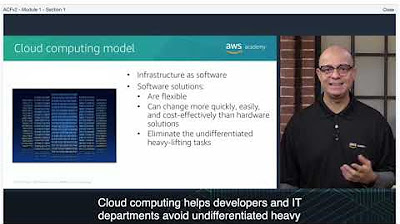Oracle EPM - Introducing Profitability and Cost Management Cloud Service (PCMCS)
Summary
TLDRIn this video, Steve Hichman and Mura Gayson introduce Oracle's Profitability and Cost Management Cloud Service (PCMCS), emphasizing its flexibility, accuracy, and transparency in financial allocations. They discuss how PCMCS integrates seamlessly with the general ledger and planning systems, allowing businesses to effectively manage and allocate costs. The demo showcases user-friendly features such as point-and-click rule creation, comprehensive reporting, and traceability of allocations. The presenters highlight the tool's ability to meet compliance and audit requirements, making it essential for organizations dealing with extensive allocations. Overall, PCMCS is positioned as a valuable resource for effective financial management.
Takeaways
- 😀 PCMCS is a key component of Oracle's Enterprise Performance Management suite, focusing on allocations.
- 📊 The tool effectively integrates with both the general ledger and planning components of Oracle systems.
- 🔍 Allocations are common in shared services like IT, HR, and facilities, addressing complex organizational needs.
- 📝 Many organizations currently rely on Excel for allocations, which can lead to inconsistent and mixed results.
- ⚡ PCMCS offers flexibility, allowing businesses to adapt to changes and evolving allocation methodologies.
- ✔️ The tool ensures accuracy, providing confidence in data integrity for better decision-making.
- 🔑 PCMCS promotes transparency by enabling users to drill down into allocation details easily.
- 🖥️ Its user-friendly interface features point-and-click functionality for straightforward rule design.
- 📈 Users can monitor allocation rules and easily identify unallocated costs through intuitive traceability features.
- 📑 The tool provides out-of-the-box reporting capabilities, essential for compliance and audit requirements.
Q & A
What is the main focus of the Profitability and Cost Management Cloud Service (PCMCS)?
-The PCMCS focuses on allocations and has a strong integration with the Oracle General Ledger and planning components.
What are some common applications of allocations in organizations?
-Common applications include shared services like IT, HR, and facilities, as well as regulatory reporting and tax compliance.
What challenges do organizations face with current allocation methods?
-Many organizations rely heavily on Excel and face mixed success with different tools for allocations.
What are the three key benefits of the PCMCS tool?
-The key benefits of PCMCS are its flexibility, accuracy, and transparency, allowing users to see detailed allocation processes.
How does the user interface of PCMCS facilitate the allocation process?
-PCMCS features a user-friendly GUI with a point-and-click interface that allows business users to drive the allocation process without needing technical expertise.
What is the purpose of the rule dimension in PCMCS?
-The rule dimension in PCMCS is used to classify each allocation rule with a unique ID, which helps in tracking and managing allocations.
How does PCMCS ensure transparency in allocation rules?
-PCMCS provides insights into each allocation rule and allows users to trace unallocated costs easily, promoting transparency in the allocation process.
What feature allows users to analyze unallocated costs in PCMCS?
-PCMCS includes a functionality that enables users to click on reminders to identify unallocated costs and perform detailed analysis through a smart view link.
How does PCMCS support compliance and audit requirements?
-PCMCS generates program documentation reports automatically, providing a permanent record of allocation rules for audit purposes.
What was the presenters' final recommendation regarding the PCMCS tool?
-The presenters recommend that organizations with extensive allocation needs consider exploring the PCMCS tool further, as it is gaining traction in the market.
Outlines

This section is available to paid users only. Please upgrade to access this part.
Upgrade NowMindmap

This section is available to paid users only. Please upgrade to access this part.
Upgrade NowKeywords

This section is available to paid users only. Please upgrade to access this part.
Upgrade NowHighlights

This section is available to paid users only. Please upgrade to access this part.
Upgrade NowTranscripts

This section is available to paid users only. Please upgrade to access this part.
Upgrade Now5.0 / 5 (0 votes)





